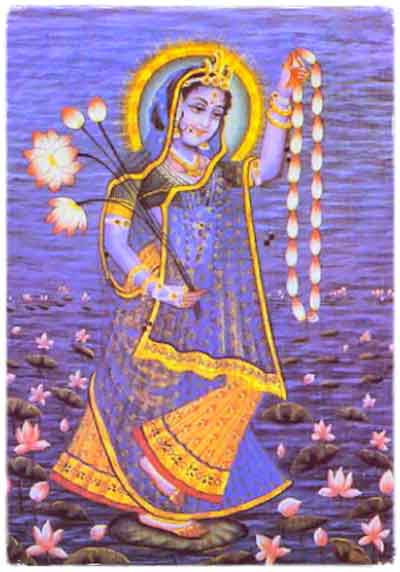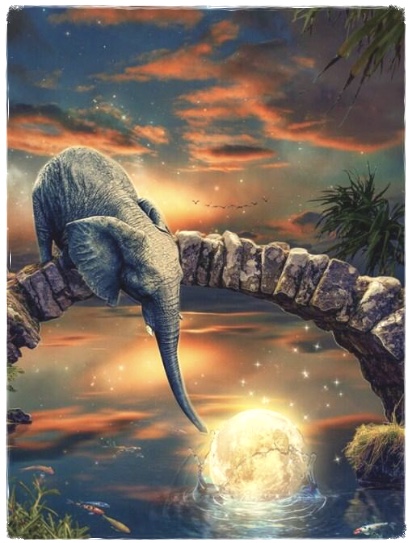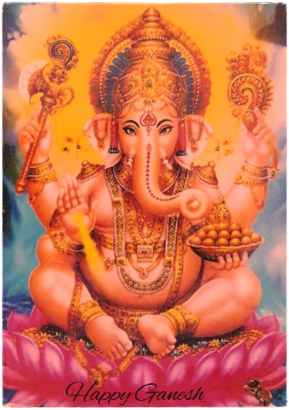#BHARANI #NAKSHATRA

THE WOMB OF LIFE & DEATH
“CONFUCIUS SAID.
A SEED GROWS WITH NO SOUND, BUT
A TREE FALLS WITH A HUGE NOISE.
DESTRUCTION HAS NOISE, BUT CREATION
IS QUIET.”
Bharani Nakshatra is the lunar house that deals with the mysteries of #life and #Death.The symbol of this Nakshatra is a #Yoni, which means the female vagina,The ruling planet of Bharani is #Shukracharia ( #Venus) The god of Bharani Nakshatra is the lord of death and justice, known as #Yamaraja. Yamaraja is lord of the South. Yamaraja literally means the king of binding restraint. He carries the Pasa (noose) with which he binds and draws the soul out of the body at the appointed time.He is said to have been the first immortal being to have experienced death. As the first to taste death, he became the god of death and king of the ancestors. He is the first ancestor to have paved the way.The father of Yamaraja is Surya the #Sun. It is of interest to note that the sun gets exulted in the constellation of Bharani. That means, the best qualities of the sun, astrologically-speaking, are empowered by its exaltation here.Yamaraja has a twin sister named #Yami and a brother named #Shuni ( #Saturn) Just as in the case of Shuni, the animal associated with Yamaraja is the #Crow.
Yamaraja, gives the Karmic results of one’s present actions in the future, whereas Shuni gives one the results of past actions in the present. We see that a Shuni (Saturn) has its debilitation point in Bharani Nakshatra. Interestingly, the stories point out that Shuni and his older brother Yamaraja do not get on very well.Debilitation of a planet, astrologically-speaking, is when it’s effect is weakened. Debilitation is the opposite of exultation. Consider also the exulted sun in Bharani. Saturn and the Sun are inimical to each other. It was Shuni who caused his father to go into eclipse by a mere gaze.
The Justice of Yamaraja, is not a punishment as we might perhaps be apt to think of it. Justice in our world might seem like restriction and punishment, but justice for Yamaraj is reflection, reverberation and the law of effect.If for example, we drink a glass of castor oil, it will have a particular effect in the Southern Hemisphere of our being. It might not be pleasant, but it has nothing to do with punishment.
Bharani means to bear weight. To bear a child, to take responsibility. The symbol of Bharani Nakshatra is a Yoni. The Yoni offers life into manifestation. This is more than just the feminine symbol of sex and reproduction. We know that the Yoni bears life into this wold physically, like a portal or doorway. On another octave, the spiritual principle of Yoni bears spiritual life. Yoni is a sacred word. It is a sacred doorway into existence. This sacred Yoni is called by many names. Some words for the sacred Yoni are some of the most derogatory of the language. It is worth pondering why the Yoni bears so many words of derogatory connotation. These are perhaps hidden words that are not part of pleasant society. Words like cunt, fanny, gash, pussy or fuck-hole are a sexualisation of the sacred door of the Yoni. They are words that carry a power, but they also depart with the full range of power and sacredness of the Yoni. These descriptions may certainly be an aspect of the Yoni, but they tie the energy of the Yoni to a minuscule corner and portion of its power. The power of the Yoni is infinite. It is the power of the sacred doorway. It is the doorway that carries spirit into manifestation.
A thought is conceived and an action is undertaken. That is energy graduating through the layers, from the psychic realm unto the physical.Let us take a practical example of this principle in action:
You may be at home with no ingredients in the Kitchen. You may conceive an idea to bake a cake. The application of your intention follows with a bit of shopping, stirring, pouring and mixing. The house soon is scented by the sweet fragrance of a baking cake, and then soon after, the cake stands grandly upon the table.The cake was conceived as a psychic conception, and after a creative process, has taken birth and is ready to eat. This is the principle of the womb of conception, and the Yoni of manifestation that Bharani presents.
The cake comes into manifestation through the psychic principle of Yoni.Baking may be fun, sweet, warm and tasty. But that is not all that it is. Baking can also involve getting burned.If we divorce the cake from the art of baking, then we get a store-bought one, rather than the birth and living artistry of our creative faculties.
So when considering the Yoni of Bharani, we are to look beyond the hole that carries the function of sex and childbirth. It is verily the channel of the creative womb. It carries creative force by pouring into manifestation. Working with the star of Bharani is to work with and worship of the sacred Yoni.
Bharani Nakshatra is ruled by Shukracharia. This is Venus. To the Tantrics, he is the #Guru #of the #Asuras. Shukra literally means the male seed essence. When the seed enters the Yoni, it has the potential to create life.These two energies of seed and Yoni, obviously work like that upon the physical plane. But this is the tangible aspect of the manifestation of a subtle phenomenon. The psychic, or even physical seed or Shukra meeting the Yoni, does not lead to instantaneous manifestation. First it must find the doorway in, it must grow, and then it must find the doorway out and into manifestation, just like the baby, or the cake baking. It is a process of gradual enlivening and manifestation. The store-bought cake, of course exists. But it’s not our conception, in the same way that a cake baked by our own hand is.Shukracharia is the deity who is in possession of a special Vidya (wisdom).Mritsanjeevani Vidya is the knowledge and magical power to bring the dead back to life. This is a point to meditate upon, as to why Shukracharia (Venus) should have this power to bring life to the dead. Meditate upon this and consider what it’s implications might be?
Bharani is autonomy. Its potential is conception and birth. In both a physical, and spiritual sense.Taking on a couple of fancy spiritual slogans and set of beliefs, is like going for a wholesale, fast-food, ready cut, ready packaged slice of cake. It may seem to taste fine, but it’s most probably void of Prana and life-force. When our spiritual vision is truly conceived from the sacred Yoni in our soul, then it is different to taking on a ‘store-bought-ideology’. To truly birth a spiritual view, the seed of effort must be ploughed into a fertile soil. This takes patience, work and the awareness of timing.Tapasya is the drive of the seed. It is planting in the garden of the soul. The sacred Yoni is the very garden of our soul.
The place between life and death is the realm of Yamaraja, his world is called Naraka. It is the place of spirits. Yamaraja is also known by the name Pretaraja, which means the king of ghosts. The land of Yamaraja, Naraka, is often incorrectly described as hell. It is a realm where one looks into the mirror of the soul and justly has their shadow reflected back to them. There is a story of the sage known as Durvasa Muni who entered Naraka that highlights this principle. When Durvasa Muni entered Naraka, suddenly it was transformed to a paradise. It was transformed because of the quality of his heart which that was full of love, sweetness and devotion.And so Naraka, is the mirror of truth. It is the real unveiled and revealed, it reflects everything, and that includes that which is hidden, buried and unresolved in our heart. Yamaraja is the grand lord of fairness and justice. He is a judge in this sense.
Yamaraja is the collecter of souls. Yamaraja means restraint and Raja implies king.He is the lord of justice. He is the well-timed restraint of destructive impulse, he is destiny. A story that demonstrates his restraint runs thus. Once he grew angry at his mother for expressing what he considered unjust behavior, and upon impulse, he went to kick her in a fit of fury.Realising what he was doing, Yamaraja restrained the swing of his foot in mid-air. Just has his name means, Yamaraja the king of restraint reigned-in his foot mid-swing, and so the fateful blow was negated.Yamaraja knew it was an Adharmic action to boot his mother with a full-pelt kick, and so he kept to the laws of Dharma and applied Ahimsa, which means non-violence.
Dharma will be considered in the section that follows the next, entitled ‘The Laws of Dharma’. Simply put, Dharma is wise action. ‘A’ as the prefix becomes a negator here, and so Adharma means unwise action.The kick was restrained but it was not without consequence. His mother saw that he had intended to kick her, and she in turn cursed his foot to rot away and be ridden with death, rotting with worms and all manner of creepy crawlies. For this reason, Yama is known as Sirnapada, which means the shriveled-up foot.And so Yamaraja had to accept the consequences of almost breaking his own codes of wise action. This was Yamaraja’s initiation into the realm of death. He got an even deeper insight and initiation into the nature of action and consequence by this.That Yamaraja was such a wise, fair and just being, is what gave him his position as the god of the law.The curse on his foot was negated by his father. And from the celestial spheres, the rotting flesh and worms fell upon the earth and brought death to our realm, which was said to have previously been a place of immortality.It is interesting that the foot symbolism appears here. The foot is the body part connected to Bharani Nakshatra. It is the Southern-most portion of the body. Yamaraja rules the Southern direction.
The Indian custom of turning the feet of the dead towards the South is worth pondering in this respect. Yamaraja rules the land of the Southern world known as Naraka. It has many divisions described in the writings, sometimes it appears like a very complex map of inner realities, whereas in reality the principle of Naraka is rather straight forward. It is the souls mirror. It’s many divisions are reflections of the inner Karma of the soul. Naraka has many names, sometimes it is called Yamalokh or Yamapur… realm or city of Yamaraja It is also known as Pitrilokh which translates at the realm of the ancestors. Its many sub-divisions have their own names, they are places where one enters the universe of their inner Karmic reality, somewhat like a psychic hall of mirrors.
Shuni (Saturn) is the brother of Yama. It is interesting to note that Shuni also has an affliction that makes him rather lame.
There are several stories of astrological significance that tell of how Shuni became lame. Let us briefly consider the story that fascinatingly correlates to the above story of kicking the mother. Shuni also went to kick his mother, but he did not restrain the kick like his brother Yamaraja had done. Shuni did actually kick his mother, and thus his foot was cursed, giving him a slow limping gate. He is in fact the slowest of the visible 9 planets of the Yogins. There is another foot story that involves Yamaraja, that we will now consider as we travel further South, to the section directly below. This time it is Yamaraja who is the recipient of a kick.
Let us look at the origin of Yamaraja, the lord of death.The father of Yamaraja is the sun who is known as Surya. When the Suns wife was pregnant with Yama, Surya gazed upon her, but his light was so bright that she had to close her eyes and shield herself from his burning gaze. The Sun took it as an insult to his pride, and in a fit of fiery rage, he cursed his wife to give birth to a child that would be the destroyer of humankind. That child was born as Yamaraja.And indeed Yamaraja became the great god of mortality.This is an important point in grasping the energy and secret of this Nakshatra. Consider, if you will, that Bharani rules the womb and the Yoni. The womb is the place of conception and the Yoni is the place of birth. While Yamaraja was still in the womb, he had the curse of the planetary solar-force thrust upon him.
That curse became Yamaraja’s destiny after he was born. This story points at what we discussed in the first section, of how the conception of a thing begins with an impulse… as in the wish to bake the cake. The energy and intent of the conception manifests in the birth and in the destiny.
As soon as a soul is born as a mortal upon the earth, the assistants of Yamaraja start to move closer. From the very first breath, death is marked, and Yamaraj’s attendants who are known as the Yamadutas, move ever closer.Upon the last breath, they take the soul to Yamalokh, which is the world of Yamaraja. There the soul goes to meet the grand king of Justice who is Yamaraja.
There are a few rare instances of souls escaping Yamaraja one particular story concerns the allotted death of a young boy that echoed back upon Yamaraja as his very own death.
Markandeya Rishi was a sage who was destined to die at 16 years of age.
Markandeya was a Yogi who worshiped Shiva day and night. He is said to be the legendary author of Chandi Partt. This is a mantra dedicated to Durga.
When his 16th year arrived, the attendants of Yamaraja came to take him to their lord.
Markandeya held on tight to the stature of the Shiva lingam and prayed to live. So intense was his resolve that the Yamadhutas could not extricate him from his grip upon the Shiva Lingam.
Then Yamaraja himself came riding on his Buffalo with his noose in hand, ready to lasso the youth and take him to the realm of justice and truth. Normally the personal assistants who are known as the Yamadutas come to collect the soul. Yamaraj only comes on rare occasions when the soul is very powerful. The Yamadutas are the Pitris (ancestors) they are sometimes pictured as hideous frightening beings. Again, they are like the mirror of Naraka, they appear as a reflection of our soul. What is of note here is that Bharani Nakshatra holds the energies of ancestral-generational curses and misfortunes. We have already seen in the narrative of the story, a surprising interplay of curses going on, the curse of the mother upon the son and the father also laying a curse upon the unborn fruit of the womb that was to ripen into Yama, the god of Bharani Nakshatra.
The death that Yamaraja brings, can also be taken to mean the opportunity to meet the death of cycles of generational and ancestral Karma.
On with the story, Yamaraja cast his noose towards the boy, but it lassoed both the boy and the Shivalingam. Yamaraja set off on his Buffalo and attempted to draw the boy into his realm.
Shiva was enraged by this behavior of Yamaraja, both for taking his devotee in his sacred place, and for lassoing the lingam in which Shiva himself lived.
And so Shiva appeared from the lingam and kicked Yamaraja with thunderous force on the chest. Yamaraja died and Markendeya was saved. The form of Shiva that killed Yamaraja in a rage is known as Kalanataka, which means the destroyer of time.
Things seemed fine for a time. But with Yamaraja the great lord of death out of action, people stopped to die and the earth began to sink from the weight into the waters.
The universal gods pleaded with Shiva to restore cosmic order by bringing Yamaraja back to life. This was duly done on condition that Markandeya was out of his reach. And so life and death went on as usual once again.️
The realm of Yama is separated from the earth by a river known as the Vaitarni. The river is said to change according to one’s Karma.For those who follow Dharma is is filled with elixir, for those who follow Adharma it becomes blood. It can become utterly noxious, filled with rotting flesh and excreta. The river Vaitarni mirrors one’s inner Karma accordingly. The toxins in ones soul are simply reflected in the river. It can be filled with hideously brutal underwater animals, and it can even burst into flame. The river to the Kingdom of Yamaraj reflects the truth of our soul back to us. On the way to the great lord of justice there is no avoidance of what is in our heart. There is no hiding behind actions and self created delusions, even our good intentions and Karma hides not the truth of the soul when on the way to Yama.It may be noted that the river Vaitarni is somewhat reminiscent of the River Styx of the Greek mysteries.
We have looked at the Yoni that bears us into life. The impulse that begins in the womb and expresses itself through the door of Yoni into manifestation.This is half of the power of the sacred Yoni.The other half of the Yoni is the doorway that takes us out of manifestation. Towards another level of being. This is not the Yoni of birth, but the Yoni of death.The dark mysterious vortex that draws the manifest back into itself.The physical Yoni takes the seed of life into itself, like a death from one life towards the growth of another.It is of note to consider that Shukracharia is the Yogic name for Venus, Shukra is the male seed and Charia means the deliverer.The seed of life is delivered into the Yoni of Bharani.This holds true on a multiplicity of levels.Yamaraja is the force that delivers the seed of our life into the Yoni of Bharani towards the womb of death, to the place where the forces of creation and death meet.His realm is just a hint beneath the surface. It is the universal sex chakra.

A story tells that Yamaraja had a sister who was named Yami.
Yami and Yama were twins. Even though she was his sister, she had a kind of obsession with him sexually, and did her utmost to seduce him. Yami desired Yama, and just longed to be in sexual union with her brother. She tried and tried her best to allure, persuade and manipulate him in every way possible, but Yam was resolute in his refusal. His resolution in this and many other cases, to always adhere to what he thought was wise action, is what earned him the name Yamaraja.
When Yamaraja died at the hand, or rather foot of Shiva, – as the story in the last section above highlighted – his twin sister Yami could not stop weeping.She cried the river Yamuna into being, Yami is also called Yamuna Devi for this reason. She cried uncontrollably from an unrequited love for her brother.The gods could not stop her tears which threatened to drown the whole creation, and thus was created the night, so that Yami would stop crying and forget and go to sleep. Previous to her tears there was no night.
Yamaraj represents Dharma (which is the topic of the following section) and Yami represents its opposite of Adharma.
Yamaraja is Dharmaraja. Dharma is wise action, it is often interpreted as justice, righteousness and rules. Yama stands for the principles of wise action that he believes in. He is firm in Dharma. This is why he is appointed as the lord of justice and fair retribution.
Rather than a punisher or a mere dispenser of retribution, Yamaraja is a mirror of fair reflection, The stories that we have considered thus far of his life and death, point to his concern with action and its outcome and effect. He himself bridled his impulse of violence against his mother in a moment of rage. Yamaraja is possessed of the utmost resolve and restraint in the dramatic fires of sentiment and emotion, Yamaraja is dignity par excellence.
He is not a cruel punisher as he might be portrayed. Certainly powerful and imposing, riding on a mighty Buffalo while chanting the Mantra Hala Hala!… from out the underworld caverns of his powerful belly. Hala Hala! is the poison that only Shiva can drink. Hala Hala! is the ritual cry of the Tantric Yogin
Yamaraja is dark and imposing in the way he reflects that which we have not faced. He reveals the Karmic accounts that we have woven. His only punishment, if it can be called that at all, is the mirror of absolute justice and true reflection.
Yamaraja means rule and restraint, to tie, and to bind. The Yogic Yamas and Niyamas are the rules of, and the fruits of Dharma. They are the rules of action that do not weave one into complexities of Karma. We will look at the laws of Dharma in a list below.
The tenants of Yamaraja are the laws of Dharma. They are sometimes called the dont’s and the do’s. They can be given a multiplicity of meanings and are interpreted in various ways according to the essential meaning. This is a subject where each Yama and Niyama can be talked on extensively in the context of Yogic practices. For now let a very basic list suffice.
Some writing give 5 Yamas and Niyamas, while some give up to 10 or more. The Yamas are the rules of Dharma, the restraint. Yama actually means to rein something in. This is interesting because the power-object of Yamaraj is a noose, with which he lassos and reins in the soul when it’s time has come to go to Naraka.
None can escape the noose of Yamaraja. But actually, there was one character who did, as we have already seen above in the ‘escaping and killing death’ section. We could say that the Yamas are the rules of Dharma, while the Niyamas are the fruits of Dharma.
Here they are listed below:
YAMAS
Ahimsa – kindness, non-harming
Satya – truth, honesty
Asteya -not taking
Bhramacharini – honour of the sacred sexual energy that we carry
Aparigraha – cultivating contentment, studying discontent.
Ksama – patience
Dhriti – power of will
Daya – compassion
Arjava – sincerity
Mitahara – measured
NIYAMAS
Shucha – clarity
Santosh – acceptance
Tapasya – effort
Svadhyaya – introspection and study
Ishvharapranidhana – focus on seeing reality
Siddhanta Sravana – study of ancient teachings
Hri- healing the past by humility.
Mati – reconciliation of opposites
Japa – Mantra chanting
Huta- doing ritual
Yamaraja rules the word of the departed from his throne which is known as Vicharabhu. The name of his throne is derived from the root vicharati, which means to move in all directions. His seat of power has the power to follow the soul into its deepest corners and most hidden recesses.Yamaraja reflects the souls Karma back to it. For this he has an important helping assistant with him. A kind of left hand-man at his side. This is Chitragupta. Chitragupta is the divine record keeper who sees everything, both hidden and revealed. Chitragupta assists Yamaraja in revealing the colours of the soul.In some ways, we could think of Chitragupta as the Akashic-Chronicle of all recorded events. Chitragupta keeps a register that records all things. This register is known as Agrasandhani.It records everything, from the most secret thoughts, to the most obvious actions.
The Name Chitragupta is worth looking at here. Chitra means luminescent, sparkling like a jewel, just like the Nakshatra of Chitra which represents the celestial jewel. Gupta means hidden, veiled, secret or dark. So, implicit in the name of Chitragupta, is the principle of seeing both the revealed and the hidden. And this is exactly his role. He assists Yamaraja in revealing all the corners of the souls who enter his after-life Domain. In Naraka, the medium and skin that covers the innermost self is stripped away, the clothing of the body and identifications with our actions is stripped bare.
It is to be remembered that Tantra is a most practical subject. We have here looked at some of the symbols of Bharani Nakshatra. Each principle that we have considered contains an inherent lesson and subject of meditation.By pondering upon symbols and principles of Bharani Nakshatra, we get acquainted with its secret. Every Nakshatra carries a deep life lesson to us. Reading a few facts about stars and gods is easily forgotten as a useless clutter of information if the heart is not involved to look deeper into the eternal symbols of destiny. If Bharani is a star that teaches anything, then it teaches creative and deep involvement with that which we are doing.
And so, the eternal cycle continues to dance between life and death. Out of one Yoni and back into another. Both life and death are conceived in these wombs of Bharani… and finds entrance or exit through the door-like Yoni that swings both ways.
https://www.ancient-tantra.com/62-bharani-nakshatra/





